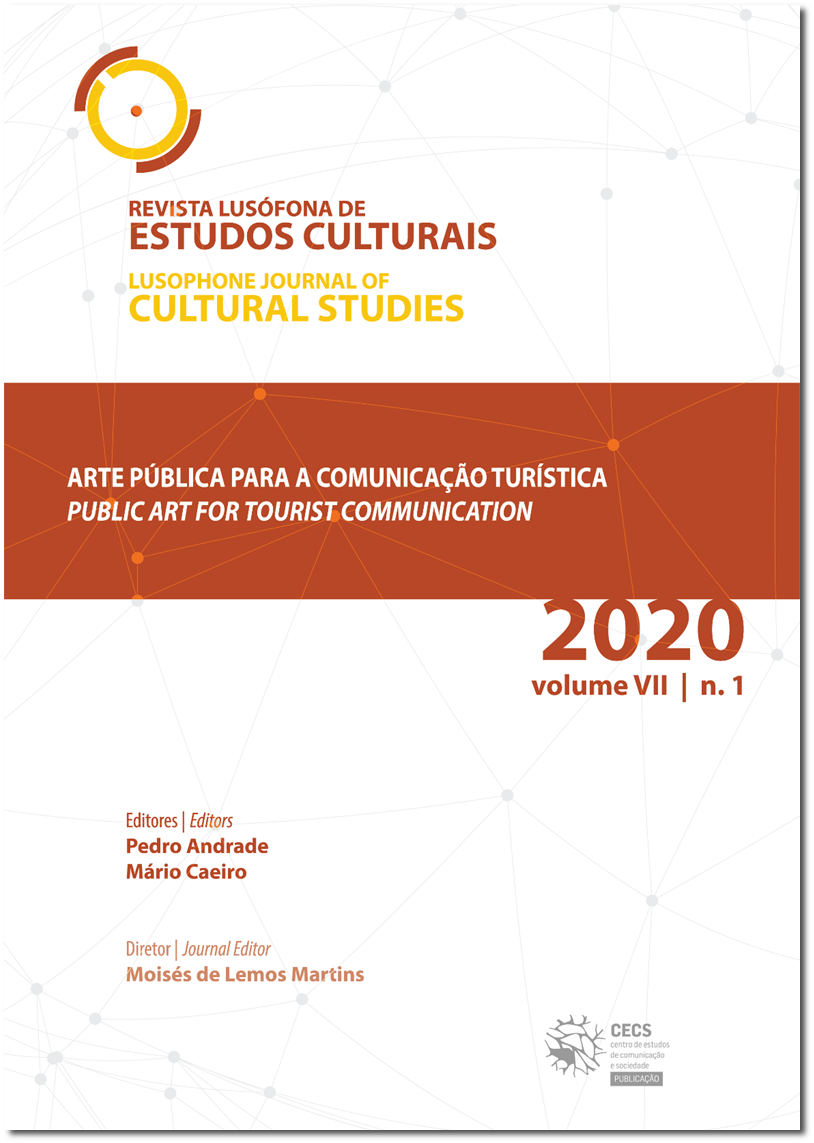Mobile applications for cultural tourism. St. James Way
DOI:
https://doi.org/10.21814/rlec.2126Keywords:
mobile apps, St. James Way, CHIC, augmented reality, cultural tourismAbstract
This article presents the result of the study on mobile applications (apps) in the area of Cultural Tourism for the St. James Way. This study was developed within the scope of activity B2 “Content management belonging to the national cultural heritage based on open systems of preservation and interaction” of the CHIC project – “Cooperative Holistic View on Internet and Content” (POCI-01-0247-FEDER-024498). Activity B2 aims to design and implement a platform for the development of mobile applications, which supports advanced media contents such as augmented reality, 360º video and georeferenced data, with the development of an application for the St. James Way. In this article, the main characteristics of existing mobile applications for the St. James Way are presented and analyzed.Downloads
References
Antunes, A. & Amaro, S. (2016). Pilgrims’ acceptance of a mobile app for the Camino de Santiago. In A. Inversini & R. Schegg (Eds.), Information and communication technologies in tourism (pp. 509-521). Cham: Springer. https://doi.org/10.1007/978-3-319-28231-2_37
Antunes, Â. (2016). Caminhar na era tecnológica em direção a Santiago de Compostela: Estudo do uso de uma app por parte dos peregrinos. Dissertação de Mestrado, Escola Superior de Tecnologia e Gestão de Viseu, Portugal.
App Annie (2018). App Annie 2017 retrospective report. Retirado de https://www.appannie.com/en/insights/market-data/app-annie-2017-retrospective/
Correia, A. & Crouch, G. I. (2004). Tourist perceptions of and motivations for visiting the Algarve, Portugal. Tourism Analysis, 8(2), 165-169.
Costa, A. (2017, 17 de julho). Crescimento do turismo em Portugal deve-se a mudança no paradigma da oferta. Diário de Notícias. Retirado de https://www.dn.pt/lusa/crescimento-do-turismo-em-portugal-deve-se-a-mudanca-no-paradigma-da-oferta---antonio-costa-8643628.html
Crompton, J. L. & McKay, S. L. (1997). Motives of visitors attending festival events. Annals of Tourism Research, 24(2), 425-439. https://doi.org/10.1016/S0160-7383(97)80010-2.
Dias, M. P. (2018, 21 de janeiro). Gastamos cada vez mais dinheiro em aplicações móveis. Notícias ao Minuto. Retirado de https://www.noticiasaominuto.com/tech/940676/gastamos-cada-vez-mais-dinheiro-em-aplicacoes-moveis
Dickinson, J. E., Ghali, K., Cherrett, T., Speed, C., Davies, N. & Norgate, S. (2014). Tourism and the smartphone app: capabilities, emerging practice and scope in the travel domain. Current Issues in Tourism, 17(1), 84-101.
Drule, A. M., Chiş, A., Băcilă, M. F. & Ciornea, R. (2012). A new perspective of non-religious motivations of visitors to sacred sites: evidence from Romania. Procedia - Social and Behavioral Sciences, 62, 431-435. https://doi.org/10.1016/j.sbspro.2012.09.070
Gavalas, D., Konstantopoulos, C., Mastakas, K. & Pantziou, G. (2014). Mobile recommender systems in tourism. Journal of Network and Computer Applications, 39, 319-333. https://doi.org/10.1016/j.jnca.2013.04.006
Glaesser, D. (2006). Tourism in a changing world. In D. Glaesser (Ed.), Crisis management in the tourism industry (pp. 1-8). Oxford: Elsevier.
Kim, S. S., ChoongKi, L. & Klenosky, D. B. (2003). The influence of push and pull factors at korean national parks. Tourism Management, 24(2), 169-180.
Lamsfus, C., Wang, D., Alzua-Sorzabal, A. & Xiang, Z. (2015). Going mobile: defining context for on-the-go travelers. Journal of Travel Research, 54(6), 691-701.
Lim, T. Y. (2012). Designing the next generation of mobile tourism application based on situation awareness. 2012 Southeast Asian Network of Ergonomics Societies Conference (SEANES) (pp. 1-7). Langkawi, Kedah, Malaysia. https://doi.org/10.1109/SEANES.2012.6299599
Lopes, F. (2000). O programa de incremento do turismo cultural – dos novos conceitos e motivações sobre o património cultural à criação de produtos turísticos de qualidade. Antropológicas, 4, 243-250.
Miller, C. C. (2012, 19 de setembro), Google updates android maps app as apple moves on. New York Times. Retirado de https://bits.blogs.nytimes.com/2012/09/19/google-updates-android-maps-app-as-apple-moves-on/
Morgan, M. (2006). Making space for experiences. Journal of Reital & Leisure Property, 5(4), 305-313.
Nayebi, F., Desharnais, J.-M. & Abran, A. (2012). The state of the art of mobile application usability evaluation. In 2012 25th IEEE Canadian Conference on Electrical and Computer Engineering (CCECE) (pp. 1-4). Montreal, QC, Canada. https://doi.org/10.1109/CCECE.2012.6334930
Nickerson, R., Austreich, M. & Eng, J. (2014). Mobile technology and smartphone apps: a diffusion of innovations analysis. In Twentieth Americas Conference on Information Systems (pp. 1-12). Savannah.
Nielsen, J. (2000). Designing web usability: The pratice of simplicity. USA: New Riders Publishing.
Oh, S., Lehto, X. Y. & Park, J. (2009). Travelers’ intent to use mobile technologies as a function of effort and performance expectancy. Journal of Hospitality Marketing & Management, 18(8), 765-781.
Palumbo, F., Dominici, G. & Basile, G. (2014). The culture on the palm of your hand: how to design a user oriented mobile app for museums. In L. Aiello (Eds.), Handbook of research on management of cultural products: e-relationship marketing and accessibility perspectives (pp. 225-244). Hershey, PA, USA: IGI Global.
Paul, K. & Mourad, M. (2017, 04 de setembro). Saudi arabi seeks islamic islamic tourism boost in test for heritage, tradition. Reuters. Retirado de https://www.reuters.com/article/us-saudi-haj-tourism-idUSKCN1BF1XW
Pelo turismo sustentável nos Caminhos de Santiago (2018, 16 de março). Público. Retirado de https://www.publico.pt/2018/03/16/fugas/noticia/turismo-sustentavel-nos-caminhos-de-santiago-1806893
PENT, Plano Estratégico Nacional de Turismo. (2012). Plano estratégico nacional do turismo: horizonte 2013-2015. Retirado de http://www.turismodeportugal.pt /
Pires, M. L. B. (2006). Teorias da cultura (2.ª ed.). Lisboa: Universidade Católica Editora.
Proteção Civil cria plataforma digital para apoiar os peregrinos (2017, 06 de abril). Jornal de Notícias. Retirado de https://www.jn.pt/nacional/protecao-civil-cria-plataforma-digital-para-apoiar-peregrinos-5775986.html
UNWTO, World Tourism Organization. (2017). UNWTO Tourism highlights: 2017 edition. Madrid: UNWTO. https://doi.org/10.18111/9789284419029
Uysal, M. & Jurowski, C. (1994). Testing the push and pull factors. Annals of Tourism Research, 21(4), 844-846. https://doi.org/10.1016/0160-7383(94)90091-4
Xunta de Galicia. (2014). Smart turismo: plan de desenvolvemento das TIC no eido do turismo. Retirado de https://transparencia.xunta.gal/c/document_library/get_file?folderId=687714&name=DLFE-22454.pdf
Yoon, Y. & Uysal, M. (2005). An examination of the effects of motivation and satisfaction on destination loyalty: a structural model. Tourism Management, 26(1), 45-56. https://doi.org/10.1016/j.tourman.2003.08.016
Downloads
Published
How to Cite
Issue
Section
License
Authors own the copyright, providing the journal with the right of first publication. The work is licensed under a Creative Commons - Atribuição 4.0 Internacional License.












